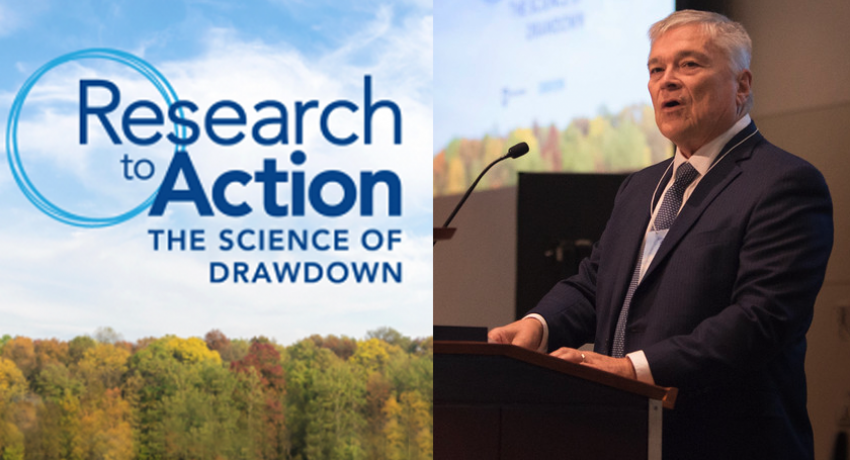President Eric Barron of Penn State speaks at the opening ceremony of the Drawdown conference. Photo credit: Patrick Mansell/Penn State
By Walt Mills
A few weeks ago the novelist Jonathan Franzen published an article in which he essentially gave up on the prospect of controlling the emission of greenhouse gases into the atmosphere, concluding it was time to begin preparing for a future filled with the risk of devasting environmental disaster. It was the culmination of all the bad news we have heard about the changing climate, and I, and many others, was filled with a growing sense of hopelessness.
At this point, over 60 percent of Americans admit that the climate is heating up and most think that humans are the cause. But many people have moved directly from denial to despair. Then, last week, I attended the first international Drawdown conference held on Penn State’s University Park campus. In a matter of days my despair turned into hope, and I saw a future that not only solved climate change but added to the general well being of the entire planet.
Drawdown is the point at which CO2 emissions level off and begin to decline. That point, the presenters claim, is the year 2050, only three decades into the future. In order to reach their goal, we will need to halve the amount of greenhouse gases entering the atmosphere each decade. To reach this ambitious goal, the Drawdown team identified and ranked the 100 most urgent problems and their solutions, starting with the 40 percent of food wasted worldwide.
Despite the claims of climate skeptics, none of the solutions discussed at Drawdown involved the usual shibboleths such as banning meat or grounding airplanes. Neither will we need to spend trillions of dollars, making paupers of the nations of the earth. Indeed, the solutions come with opportunities to make profits for new and emerging industries who join in the global effort.
One of the most memorable solutions involves the oceans, where aquatic life has been disrupted by the warming and nutrient depletion of the surface layers of the sea. According to one presenter, 93 percent of life in this region has disappeared, disrupting the livelihood of tens of thousands of fishermen and imperiling the food supply of millions more. The solution, which has already been successfully implemented, involves using pipes to push cold water from lower and colder regions of the ocean in order to replenish the nutrients that have disappeared. At the same time, kilometer wide kelp beds are planted that absorb CO2 and provide the habitat for aquatic life. Kelp is a high-quality source of nutrition for humans, with large commercial possibilities.
Another example of the multiple benefits of Drawdown involves the education of girls and women in developing countries. Education empowers females who become better small farmers, but also cuts the birthrate in conjunction with family planning. One presenter suggested that having fewer babies is the single most powerful solution to climate change.
It is widely understood that solar energy is a necessary solution to climate change, but it is not so recognized that the adoption of solar technology is rapidly advancing. In a graph shared at one session, the line representing the rise of solar power went from a slow and steady upward slope in the last decade to a straight line upward in recent years. Finland, for example, projects net zero emissions in all sectors of the economy by 2030. This indicates that every country is capable of reaching net zero by 2050.
Another panelist noted that if the Drawdown list had been created in the year 2000, the number one problem would have been the energy required for lighting. Today, due to the advances in LED technology, lighting doesn’t even make the list.
Drawdown solutions have cascading benefits, raising prosperity and providing a just economy that spreads out to every region and every strata of society. No leader or country can slow the momentum that Drawdown is propelling. Don’t despair, we can solve climate change and leave a cleaner and healthier world for our children’s children.

